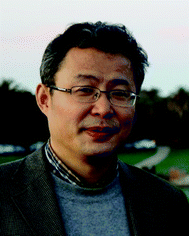Introduction to Biosensors
Ning
Gu
 a and
Shaoqin
Liu
a and
Shaoqin
Liu
 b
b
aSchool of Biological Science and Medical Engineering, Southeast University, Nanjing, 210096, China. E-mail: guning@seu.edu.cn; Tel: +86-13072532619
bHarbin Institute of Technology, Harbin, 150080, P. R. China. E-mail: shaoqinliu@hit.edu.cn; Tel: +86-18646306877
The rapid and accurate measurement of molecular entities such as small ligands, protein biomarkers, genes and cells is among the major challenges in understanding the biological arena and medical diagnosis and monitoring. The development of new biosensing technology and devices offers opportunities for bioscience research and clinical diagnosis due to their numerous advantages. In the last couple of decades, the intelligent use of new materials, including organic small molecules, inorganic materials, hydrogels, hybrids, or emerging nanomaterials and structures, has resulted in numerous new methods and techniques and enhanced biosensor performance, resulting in increased sensitivities and lower limits-of-detection by several orders of magnitude. This themed issue is devoted to a collection of excellent new advances in the novel design of biosensors and bioelectronics, and their wide range of applications in healthcare and biomedical diagnosis.
The application of fluorescence-based technologies in sensing applications for precise diagnosis of diseases is growing due to easy operation, rapid response, high sensitivity and good selectivity. The use of new fluorescent materials, including organic small molecules, inorganic materials and emerging nanomaterials and structures, is driving fluorescence-based biosensor research striving for enhanced sensitivity and selectivity. Dai et al. (DOI: 10.1039/C9TB02310K) summarized the current state of aggregation-induced emission (AIE) luminogens for sensing reactive oxygen and nitrogen species (RONS) in living systems. The rapid development of specific RONS-responsive AIE probes allows us to have a deeper understanding of the dynamic concentration changes of RONS in complex living tissues, as well as a deeper understanding of the physiological and pathological processes associated with RONS. Jiang et al. (DOI: 10.1039/C9TB02668A) review the design strategies of genetically encoded light-up RNA aptamer based sensors and their applications in detection and imaging of small molecules and RNAs in vitro and in living cells. Ma et al. (DOI: 10.1039/C9TB01889A) highlight recent advances in the development of luminescence-based methods for detecting disease-related receptor proteins in living cells employing transition metal complex-based probes and metal-based materials (e.g. quantum dots or nanoparticles). Such platforms have advantages over conventional sensing techniques in terms of quantum yield, lifetime, emission wavelength, Stokes shift, sensitivity, selectivity, redox activity, stability towards moisture/air/light, and tunable solubility. These features are crucial for the visualization of intracellular translocation, inter-protein interactions, and conformational changes of receptor proteins. Wang et al. (DOI: 10.1039/C9TB01931F) review metal–organic framework (MOF)-based multi-component ratiometric fluorescent sensors. Embedding fluorescent probes into the pores of MOFs greatly enhanced their fluorescence owing to the rotation-restricted emission and selectivity, enabling visual detection of the target analyte and realizing the simultaneous detection of multiple analytes. Mahajan et al. (DOI: 10.1039/C9TB02481F) present a magneto-fluorescent biosensor/separations platform consisting of quantum dots (QDs) and superparamagnetic iron oxide nanoparticles (SPIONs) that are separately encapsulated in amphiphilic block co-polymer micelles conjugated to DNA or protein. Parallel or sequential separation of different biomolecules can be achieved by concurrent or sequential addition of functionalized SPION micelles. The advantages conferred by the physical and optical properties of graphene-based nanomaterials have contributed to the current variety of ultrasensitive and selective fluorescent biosensor devices. Du et al. (DOI: 10.1039/C9TB02454A) proposed a toehold-regulated strand displacement strategy to accelerate the kinetics of graphene oxide-based biosensing. This strategy achieved up to 2.6-fold enhancement in fluorescence signal restoration for nucleic acid detection, while there was 3.2-fold enhancement in fluorescence signal restoration for thrombin detection. Zhao et al. (DOI: 10.1039/C9TB02388G) developed a graphene–nucleic acid biointerface-engineered biosensor, allowing target molecules to be detected with adjustable dynamic ranges and sensitivities. This aptasensor enabled accurate analysis of ATP and microorganism contamination.
Away from optical biosensors, new materials have paved the way for new and improved electrochemical biosensors. Marquitan et al. (DOI: 10.1039/C9TB02461A) fabricated a polymer/bienzyme modified carbon nanoelectrode for the determination of L-glutamate released from astrocytes upon KCl stimulation. Among electrochemical methods, electrogenerated chemiluminescence (ECL) shows a powerful analytical ability by incorporating ECL active species for sensitive detection of targets. Therefore, the development of ECL as an assay technique is constantly being pushed for better performance and lower detection limits by employing new materials and amplification techniques. Husain et al. (DOI: 10.1039/C9TB02578B) summarized recent progress in various strategies implemented for signal enhancement and amplification of ECL-based immunosensors and aptasensors. Popular enhancement strategies include DNA amplification techniques, incorporation of enzyme-assisted signal enhancement, applying new redox-active probes and luminophores, and nanomaterials for higher loading capabilities and improved ECL properties. The application of signal amplification strategies enabled the development of ECL assays with remarkable sensitivity, high selectivity, and wide dynamic range. Zhang et al. (DOI: 10.1039/C9TB02368B) reported a new multi-color ECL nanomaterial self-assembled from 3,4,9,10-perylenetetracarboxylic dianhydride and aniline through hydrogen bonding. This highly efficient ECL nanomaterial was further used to construct a label-free immunosensor for tumor marker detection.
In the medical application field, portable sensing devices with point of care testing (POCT) capability show great promise in resource-limited settings or developing countries due to their affordability, accessibility, ease of use, speed, sensitivity and accuracy. Wang et al. (DOI: 10.1039/C9TB02389E) prepare a structurally coloured contact lens sensor with a tunable colour. This contact lens sensor was made from a PHEMA hydrogel and showed great promise for instrument-free ophthalmic health monitoring. Liu et al. (DOI: 10.1039/C9TB02584G) review significant advances in the development of functional nucleic acid based paper sensors, including immobilization and functionalization methods for functional nucleic acids and signal readouts.
Moreover, a sensor that continuously collects multi-modal, whole-body physiological and mental information in the digital world can provide an integral and comprehensive overview of human health, and thus greatly enhance diagnosis accuracy and therapy output. Flexible and wearable electronics and diagnostics are emerging as powerful tools for measuring biological signals, such as pH, blood pressure, motion or biochemical components. Zhang et al. (DOI: 10.1039/C9TB02692D) highlight the most important and recent work on hydrogel strain sensors over the past five years, covering material designs, gelation/fabrication methods, stimuli-responsive principles, sensing performance and applications. Wang et al. (DOI: 10.1039/C9TB02570G) provide a comprehensive account of the latest advances in tough conductive hydrogels and their applications in flexible sensors and devices. Li et al. (DOI: 10.1039/C9TB02474C) present a broad overview of the sensing materials and manufacturing technologies of electrochemical wearable sensors for detecting various organic components and ions closely linked to human health. A review by Wang et al. (DOI: 10.1039/C9TB02352F) discusses the unique features of intraoral biosensors compared with skin electronics and implantable devices, and summarizes the design strategies of intraoral biosensors considering the diagnosis database, materials and electronics.
Current biological sensors rely on bulky external power sources that need regular replacement or charging, which greatly limits their applications. The integration of flexible power sources and sensors has the potential to revolutionize the technology of self-powered biosensors for applications in wearable sensors. A versatile device capable of both self-power and biosensing will be of great value for future applications. In this themed issue, a flexible and stretchable dual mode nanogenerator for human motion sensing and information interaction, based on the integration of piezoelectric and triboelectric principles, was developed by Liu et al. (DOI: 10.1039/C9TB02466B). The device has good adhesion and biosafety, and could work normally even in underwater environments. Enzymatic biofuel cells (EFCs) and microbial fuel cells (MFCs) hold promise as power sources for portable, wearable and especially implanted microelectronic devices. Hao et al. (DOI: 10.1039/C9TB02428J) summarize recent advances in biofuel cell-based self-powered biosensors (SPBs), focusing on the use of EFC-SPBs as power sources in combination with microelectronic and electrochromic devices, and the applications of MFC-based SPBs for on-line monitoring of toxicity, chemical oxygen demand (COD), biochemical oxygen demand (BOD) and assimilable organic carbon (AOC). The biofuel cell-based SPBs exhibited obvious advantages over conventional biosensors in practical applications, such as simple configuration and ease of miniaturization, and potential applications include clinical diagnosis, environmental monitoring, industrial process control, etc.
The articles published in this themed issue also demonstrate the diverse applications of new biosensing techniques in the biological arena and diagnostic analysis, including detection of metal ions, volatile organic compounds (VOCs) in exhaled breath samples, biomacromolecules, oxidative stress mediators in living organisms, and circulating tumor cells. Chen et al. (DOI: 10.1039/C9TB02476J) review recent advances in tissue-interfaced soft chemical biosensors. Zhou et al. (DOI: 10.1039/C9TB02518A) systematically summarize great advances in nanomaterial-based electrical, optical, and mass-sensitive gas sensors used for the breath analysis of diseases, and discuss breath sensor platforms with a multivariable sensing system, wireless communication and breath sampling, essential for predictive, preventive, personalised, and participatory (“P4”) medicine. Ma et al. (DOI: 10.1039/C9TB02458A) review recent progress in the development of nanomaterial-based biosensors for the DNA methyltransferase assay including strategies, features and applications, and highlight the future direction and challenges in this area as well. Schunk et al. (DOI: 10.1039/C9TB02666E) highlight oxidatively and enzymatically triggered biomaterial platforms and corresponding sensing outputs amenable to in vivo application for detection of oxidative and enzymatic inflammatory biomarkers. Lin et al. (DOI: 10.1039/C9TB02327E) present an overview of recent achievements in detecting circulating tumor cells using high-sensitivity SERS platforms. Ding et al. (DOI: 10.1039/C9TB02457C) review progress in the detection and release of circulating tumor cells through aptamer-functionalized nanostructured interfaces.
As the Guest Editors of this Biosensors themed issue, we are proud to bring you the latest developments in materials design and synthesis, novel designs and functions of biosensors and bioelectronics, and their wide range of applications in healthcare and biomedical diagnosis. We hope that you find the wide scope of papers presented here to be inspiring and that it drives your research endeavours further forward.
Finally, we would like to sincerely thank all the contributing authors who took time out of their busy schedules to finish the articles. Special thanks to the reviewers who participated in the reviewing process for their diligence and thoughtful and constructive criticism. We greatly acknowledge the editorial office members for their efforts in making this issue a reality.
| This journal is © The Royal Society of Chemistry 2020 |


